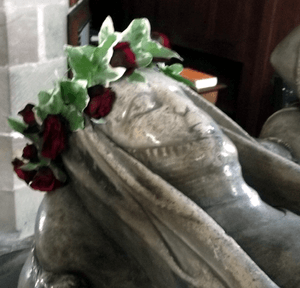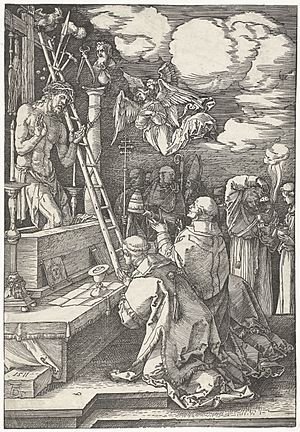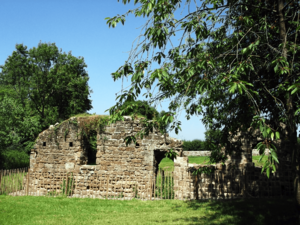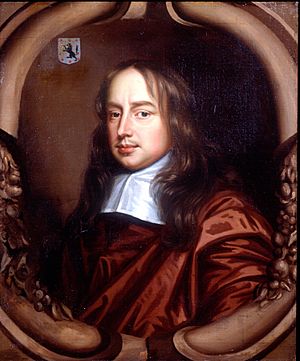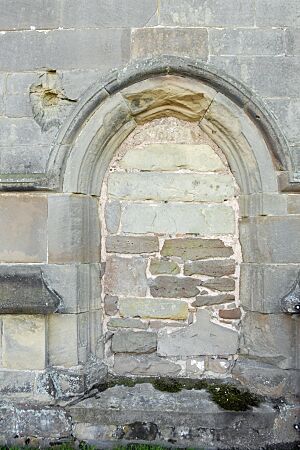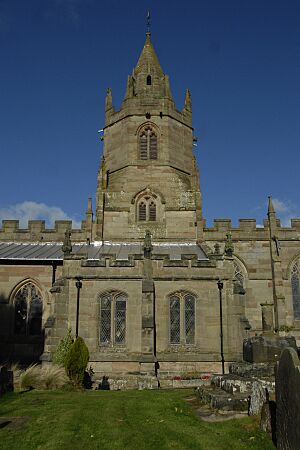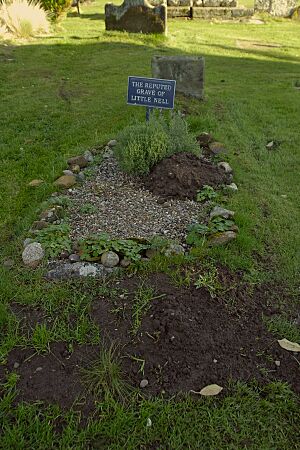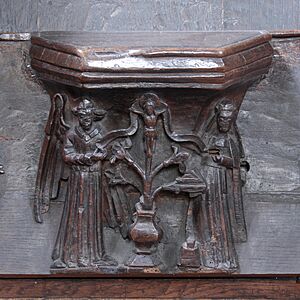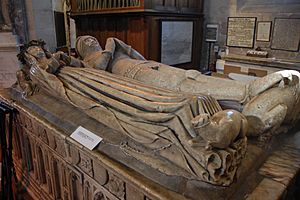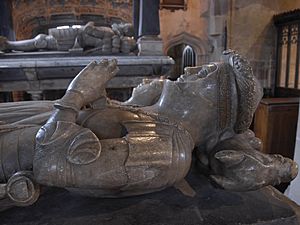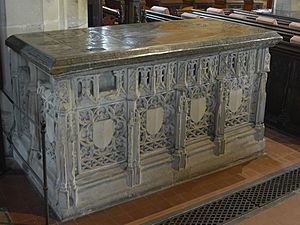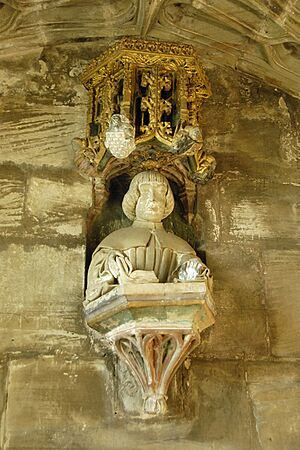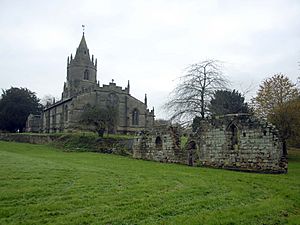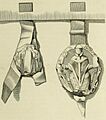St Bartholomew's Church, Tong facts for kids
Quick facts for kids St Bartholomew's Church, Tong |
|
|---|---|
| St Bartholomew's Church, Tong | |
|
|
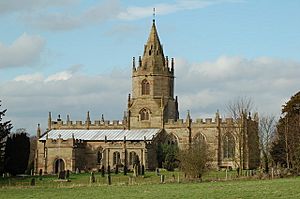
St Bartholomew's church seen from the south
|
|
| Lua error in Module:Location_map at line 420: attempt to index field 'wikibase' (a nil value). | |
| OS grid reference | SJ795073 |
| Location | Shropshire |
| Country | England |
| Denomination | Church of England |
| Website | St Bartholomew's, Tong, Shropshire |
| History | |
| Status | parish church |
| Founder(s) | Isabel Lingen |
| Dedication | St Bartholomew |
| Architecture | |
| Functional status | Active |
| Heritage designation | Grade I Listed |
| Designated | 26 May 1955 |
| Architect(s) | Ewan Christian (restoration) |
| Style | Gothic |
| Years built | 1409–1430 |
| Specifications | |
| Length | 103 feet 10 inches (31.65 m) |
| Nave width | 45 feet 11 inches (14.00 m) |
| Height | 25 feet 9 inches (7.85 m) |
| Materials | New Red Sandstone, Sherwood Sandstone Group |
| Bells |
|
| Administration | |
| Parish | Tong |
| Deanery | Edgmond and Shifnal |
| Archdeaconry | Salop |
| Diocese | Lichfield |
| Province | Canterbury |
The Collegiate Church of St Bartholomew, Tong (also known as St Bartholomew's Church) is a beautiful church built in the 1400s in the village of Tong, England. It's famous for its amazing architecture and special features inside, like its unique fan vaulting and many old tombs.
This church was built where an older church used to be. It became a "collegiate church," which meant it had a group of priests living and working together. This was started by Isabel Lingen. The church was supported by the wealthy families who lived at Tong Castle nearby. Many of the tombs inside belong to these families, especially the Vernons. Later, other important families added their memorials. One famous monument even has words written by William Shakespeare!
St Bartholomew's Church was also involved in a small fight during the English Civil War. It's also known for having the supposed grave of Little Nell, a character from Charles Dickens' book, The Old Curiosity Shop, even though she was made up! Because of its many monuments and fancy design, the church is sometimes called The Westminster Abbey of The Midlands. It's often seen as one of the best churches in England.
Contents
A Look at Tong's Earlier Churches
There was no church mentioned in Tong in the Domesday Book, a famous survey from 1087. However, a church must have been built soon after, because by 1094, the local Earl had given its rights to Shrewsbury Abbey.
Over the years, the ownership of the church's rights changed hands several times between powerful families and religious groups. There were even some disagreements about who had the right to choose the priests!
A new church building was likely built around 1260. The last owner from the Pembridge family, Sir Fulk Pembridge, was a very rich landowner. He died in 1409 without children. His second wife, Isabel Lingen, inherited Tong and many other lands. She was the one who decided to build the church we see today.
How the College Was Started
The current church was founded by Isabel Lingen after her husband died. She wanted it to be a "chantry" (a place where priests would pray for the souls of the dead) and a "collegiate church" (a church with a group of priests living together).
To make sure her new church would last, Isabel bought the rights to the church from Shrewsbury Abbey. This was very expensive, costing £40 in 1410, which was a huge amount of money back then! Isabel, along with two priests named Walter Swan and William Mosse, donated land and properties to support the new college.
The plan was to build a brand new, lasting church. It would have five or more priests, with one chosen as the leader, called the warden. The college was named "the College of St Bartholomew the Apostle of Tong."
The main reason Isabel founded the college was for priests to say regular prayers and masses for the souls of her three husbands who had passed away. But the prayers were also for the king, his family, Isabel's parents, and "all the faithful departed."
The king allowed Isabel to give the rights of the college to Richard Vernon and his wife, Benedicta de Ludlow. The Vernons were a very wealthy family and continued to support the church for many years.
Besides supporting the priests, the college's money was also meant to help thirteen poor and disabled men. Isabel also had almshouses (small homes) built next to the church for these 13 people. These almshouses were later moved and then destroyed, but one wall still stands today.
Life at the College
The college was set up quickly, with the first warden starting in March 1411. Rules for how the college should be run were approved by the Bishop of Coventry and Lichfield.
Why the College Was Important
The rules made it clear that the church's main job was to be a chantry. This meant that saying Mass was very important. In Mass, the Son (Jesus) is offered to the Father (God) to help living people and to bring peace to the dead. The rules stated that this would "most powerfully lessen the anger of our Redeemer and gain the mercy of the Saviour."
The idea was to "trade an earthly treasure for a heavenly one." People believed that special Masses could help reduce time spent in Purgatory (a place where souls are purified after death). The Masses at Tong were mainly for Isabel Lingen's husbands, their families, and the king. They also included "all the faithful departed," especially those who helped support the college.
Who Was Part of the College?
The college had five priests. The warden was the leader and was in charge of the college and the local church members. There was also a sub-warden, who was a deputy. Two other clerics (church helpers) were also part of the college.
Finally, there were 13 poor men, and seven of them had to be very ill or disabled. Once they were accepted, they could not be removed without a good reason.
The warden was chosen by Isabel while she was alive. After her death, the priests would choose the warden. The warden had to promise to follow the rules and manage the college's money carefully. He was expected to leave the college in a better financial state than when he started.
Priests were expected to confess their sins regularly. The warden would hear the priests' confessions, and the warden would choose one of the priests to hear his.
Daily Life and Services
The sub-warden was in charge of the church's services. He managed the books and church items, made the schedule, and kept track of who was absent. He also made sure there was enough bread, wine, and other items for Mass. An assistant helped him ring the bells for services.
All the priests were expected to attend every service. This helped keep them busy and avoid "acedia" (a feeling of not caring or being lazy), which was considered a serious fault. Priests were allowed a month of holiday each year, but not all at once, and they couldn't miss major festivals. If they missed a service, they would be fined.
Services followed the "Use of Sarum," a common set of rules for church services in England at the time. The day started early with Matins (morning prayers). After that, a special Mass for the Virgin Mary was said. Other Masses were said throughout the day, including one for the founders and supporters of the church. On Sundays, there would be a sermon in English for the local people.
The poor people in the almshouses were not required to attend all services, but they were expected to hear one or two Masses each day. They also had to say certain prayers daily.
In the evening, there were Vespers (evening prayers) and Compline (night prayers), followed by a hymn to the Virgin Mary. Special services were held on the anniversaries of Isabel's husbands and parents.
Priests had to buy their own special clothes for services. They could get an advance on their pay if needed, but they had to pay it back if they left early.
Living Together
The warden and priests lived together in one building. Their rooms were large, and the warden or sub-warden kept the keys to the dormitory at night. Meals were eaten together at a shared table in the college building. During meals, someone would read from the Bible.
The college aimed to provide good meals. A priest might be chosen to manage the food, keeping track of what was bought and eaten. Guests were allowed only in limited numbers, and women were only allowed if they had a good reputation and for important reasons, to avoid distractions.
Priests were warned not to go hunting or hawking, and they couldn't keep dogs without permission. They were expected to dress nicely, even when outside the college, and were encouraged to wear similar clothes when meeting outsiders.
Pay and Jobs
The warden received ten marks a year, while the other priests received four marks. This was in addition to their food and lodging, which the college paid for. They could also earn extra money for saying Masses for people who had died. All payments were made twice a year. The sub-warden, the local church helper, and the food manager received a little extra pay.
The college also had a teacher, chosen by the warden and priests. This teacher was expected to teach the church helpers, college employees, and poor children from Tong and nearby villages.
The 13 poor people in the almshouses received one mark a year in money or goods, plus their housing. This was paid in four installments.
The warden was also responsible for keeping an oil lamp lit near the main altar during services and at night, and for providing wax candles.
Priests could leave the college, but they had to give six months' notice. If they left earlier, they would lose their last half-year's pay.
Money and Resources
Tong College started with money from its original lands in Tong, Orlingbury, Sharnford, and Gilmorton. These weren't huge amounts.
A Big Gift from the King
Things got much better for the college in 1415 when King Henry V gave it Lapley Priory. This priory was an "alien priory," meaning it belonged to a monastery in France. Because England was at war with France, English kings often took over these foreign priories.
King Henry V's gift to Tong College was a big deal, even though it cost Isabel £100. Lapley Priory brought in a lot of money from its lands and churches. About 25 years after this gift, the Lapley estates provided about half of the college's total income.
This increase in money led to new rules in 1423. The warden's pay was raised, and so was the priests'. However, the priests' higher pay was never actually given, and they continued to receive the old rate.
Farming and Food
Tong College also had its own farms, especially around Lapley and Wheaton Aston. These farms produced enough grain, meat, and dairy products to feed the college members. They also had sheep and sold wool.
More Rights and Lands
In 1448, the college and Sir Richard Vernon gained special rights from the king. This gave them more control over legal matters in their area.
By 1535, the college had added two more small estates, increasing its income. Most of the college's money came from the Lapley manor.
Gifts and Wills
People also left money and gifts to the college in their wills. For example, in 1451, William FitzHerbert left money for a priest to say Mass for his soul for a year. Another person, Fulk Eyton, left money for prayers and Masses, and also a silver basin and a feather bed to the college.
Vernon's Chapel
Besides the main college, Sir Henry Vernon set up his own special chantry (a place for prayers) at Tong. He made his will in 1515, asking to be buried in a specific spot at Tong, next to his wife, Anne Talbot.
Sir Henry left money to pay a priest to serve in his chapel, which was called "the Chapel of the Salutation of Our Lady." This priest was also supposed to help with the main Mass in the church. This chantry was separate from Tong College and had its own money. Its lands were in different parts of Staffordshire and Shropshire.
The College Closes Down
Taking Over the Property
In 1546, King Henry VIII's officials were ordered to take over the property of many religious groups, including Tong College. This was part of a larger plan to close down chantries and colleges across England.
Three officials entered Tong College on September 27, 1546, and took control of its property. They also took over Vernon's Chantry and another chantry in Bakewell. Inventories (lists of goods) were made. It seemed that the properties were already planned to be sold to Sir Richard Manners.
The inventory listed foods needed for the almshouses, like grain, meat, and fish. It also listed money owed to servants. The college's goods included church clothes, beds, cooking equipment, and animals. The animals were the most valuable, worth over £10.
Selling the Lands
The official papers granting the Tong and Bakewell estates to Richard Manners were stamped in January 1547. The total value of Tong College was listed as £53 13s. 5¼d. Manners agreed to pay £486 4s. 2d. for all three properties.
Manners quickly started selling off some of the property. Less than a month later, he sold the Tong College building, the church's tithes (a portion of income), and the right to choose the priests to James and Alice Wolryche. He also sold lands from Lapley Priory to Robert Broke, a famous lawyer.
Tong Church After the College Closed
The college buildings stayed with the Wolryche family until 1648, when they were sold to William Pierrepont. He had become the lord of Tong through marriage. Since the college used to own the church's rights and tithes, William Pierrepont was able to pass them on to his youngest son, Gervase.
In 1697, Gervase Pierrepont set aside money to provide £12 a year for the six widows living in the almshouses near the church.
A map from 1739 shows that the college buildings were still large and located just south of the churchyard. However, they started to fall apart quickly after that. By 1763, much of the old college was gone, with some parts used by poor people and others as a stable. The almshouses were still there, housing "six poor widows." In the early 1800s, the owner of the Tong estate, George Durant, had the remaining college buildings torn down, leaving only a small piece of wall from the original almshouses.
Church and Castle
After the college closed, the church continued to be the center of Tong village. For about a century, the Wolryche family owned the right to choose the church's priest.
During the English Civil War, Tong Castle changed hands several times because it was near important roads. The church itself was damaged during the fighting. A soldier named Richard Symonds saw the damage in 1645, noting that the church's windows were "much broken."
William Pierrepont, who owned Tong Castle, was a member of Parliament and supported the Presbyterian church. After the war, he bought the college property, bringing the church's rights back under the control of the castle's owner. Money was spent to repair Tong church.
Later, Gervase Pierrepont, William's son, made sure the church's priest was well-supported. He gave the priest money and allowed him to live at the castle sometimes. The church continued to be a place of worship for the families who lived at Tong Castle.
Tong Castle was torn down in 1954 because it was in bad shape. The church is built on sloping land, which some believe was done on purpose so that water could flow out of the west door when the floor was washed.
The church's north door was once called the "Door of Excommunication," but it's now sealed. Above this door is a stone carving of the Royal Arms of George III, given as a gift in 1814 to celebrate peace. The whole church was restored in the late 1800s by Ewan Christian, finishing in 1892.
The church owns a special cup called The Tong Cup, made of silver and crystal. It's now kept safely at Lichfield Cathedral, but it still belongs to the church.
Like many old churches, St Bartholomew's has had its lead roof stolen multiple times. In 2017, after raising money, the church replaced the lead with steel to stop thieves.
The church is often recommended for visits because of its rich history. It has been called "The Westminster Abbey of the West Midlands" due to its history and beautiful decorations. An American consul named Elihu Burritt was one of the first to call it a "little Westminster," amazed by its "beautiful and costly monuments."
Church Bells
The church tower has a set of six bells that can be rung together. The oldest bell was made in 1593, and others were cast in the 1600s and 1700s. The largest bell, called the tenor bell, was recast in 1810.
There's also a smaller bell, called a Sanctus bell, made around 1600.
St Bartholomew's is famous for its very large "bourdon bell," which weighs over 2 tons! It was recast in 1892, the same year the church restoration finished. This "Great Bell of Tong" was first paid for by Sir Henry Vernon in 1518. It cracked during the English Civil War and was recast in 1720. It cracked again in 1848 and wasn't recast until 1892. It's said to be the loudest and biggest bell in Shropshire. Because of its size, it's only rung on special days to protect the tower.
In a story about King Charles II's escape in 1651, it's mentioned that he could hear the famous bells of Tong from his hiding place nearby.
Outside the Church
The church is built from local red sandstone, which is a dark brown color and has held up very well over time. Its low roof is decorated with battlements, pinnacles, and gargoyles.
The north side of the church walls has many musket ball holes and at least one cannonball hole. These were made during the English Civil War when soldiers fought over Tong Castle. The church was often in the middle of the fighting because it was on a main road. After the war, a soldier noted that the church was "fair" but its windows were "much broken."
A carved statue of St Bartholomew sits in a special spot on the east wall. It was made by Pat Austin, whose husband, David Austin, has a famous rose business nearby.
About 5 meters south of the South Chapel is the base of a 15th-century cross. It's made of sandstone and used to have a cross on top, but that was replaced with a sundial in 1776.
For a long time, school buildings were located in the churchyard. The college buildings, built in the 1400s, were on the south side of the church. They were mostly destroyed in 1644 during the English Civil War and later completely torn down in the 1800s.
Between the north side of the church and the vestry, there's a small area with a tiny Maltese Cross on the ground. This is called "Chrysom's Graveyard," where unbaptized babies were buried. The cross has lines from famous writers carved into it, though they are now worn away.
Little Nell's Grave
In the churchyard, there's a grave with a small metal plate that says "The reputed grave of Little Nell." This refers to the character Little Nell from Charles Dickens' novel, The Old Curiosity Shop. In the book, Nell dies in an unnamed village in the West Midlands.
Around 1910, the church caretaker, George Bowden, created a fake entry in the church records for a "Nell Gwyn" and made a grave for her. He even used Post Office ink, which was a giveaway! The grave has moved around over the years as real people were buried. Even though it's fake and Nell is a made-up character, many visitors come to see it.
Tong is thought to be the setting for Nell's death because Dickens' grandmother was a housekeeper at Tong Castle. It's said that Dickens wrote the ending of his novel while visiting her nearby. Dickens himself later described Tong church as "...a very aged, ghostly place."
Inside the Church
The inside of the church is described as a "splendid Perpendicular Gothic interior" that attracts many visitors. The church, its history, and its monuments are all listed as a Grade I listed building. The four pillars along the south side of the main part of the church (the nave) are from the original 13th-century church. The main body of the church was built in the early 1400s. The only major addition after that was the Vernon Chantry (or Golden Chapel), added in the early 1500s.
The church tower has a rectangular base that supports an eight-sided structure, topped with a short spire. The pulpit, a gift from the 1600s, stands near a pillar. It's six-sided and has the year 1622 carved on it.
The choir area has special seats called "stalls" with carvings called "misericords" from about 1480. One carving, where the warden would have sat, shows a "Lily crucifix," which is very rare.
The large east window was designed and installed by Charles Kempe during the church's restoration. It's known for its detail. Kempe also saved some 15th-century stained glass and put it in the west window.
Tombs and Monuments
The church has many monuments, tombs, and statues celebrating the lives of important people who worshipped there.
The most famous is the Stanley monument. It used to be near the altar but was moved in the 1700s. It has two poems carved on it, which are said to have been written by William Shakespeare for Sir Edward Stanley's parents. This makes Tong Church the only place where two of Shakespeare's poems are carved in stone. The tomb has statues of Sir Thomas Stanley and his wife, Margaret Vernon, on the top level. Below them is a statue of their son, Edward.
Statues of Sir Fulke and Dame Isabel de Pembrugge lie on a tomb on the north side of the tower. The tomb is made of alabaster, and some of the original black paint on Isabel's widow's dress can still be seen. Isabel died in 1446. Every Midsummer's Day, a crown of roses is placed around her head. This tradition comes from an old agreement where a local family owed a chaplet of roses to the lord of Tong.
Across from the Pembrugge tomb is the tomb of Sir Richard Vernon and Benedicta de Ludlow. It's also carved from alabaster. The Vernons lived in Derbyshire but chose to be buried at St Bartholomew's.
Further west is the tomb of Sir William Vernon and his wife, Margaret Swynfen. This tomb is made of marble and has brass figures of Sir William and his wife. Other Vernon family members have tombs near the pulpit and in the Vernon Chapel.
The Vernon Chapel, completed around 1519–1520, has many monuments, including one for Sir Henry Vernon, who built it.
In the chapel, there's a bust (a statue of the head and shoulders) of Arthur Vernon, Sir Henry's son, who died in 1517. The small fan vaulting above his head is similar to the fan vaulting in the chapel itself, which is rare in Shropshire.
War Memorials
The church has three war memorials from the 1900s. On the arch leading to the altar, there are separate plaques for people from the parish who died in the First World War and Second World War. There's also a special plaque for Humphrey Herbert Orlando Bridgeman, who went missing in action in France during the First World War.
Church Leaders
James Marshall, who was the vicar from 1845 to 1857, was known for having only one arm. He later became Catholic.
The Reverend John E Auden was the priest from 1896 to 1913. He tried to sell the Tong Cup to raise money for the church, but people in the community disagreed. He wrote many books about Tong and its church.
The Very Reverend Robert Martin Colquhoun Jeffery was the priest-in-charge at St Bartholomew's from 1978 to 1987. He later became the Dean of Worcester Cathedral and is buried in the churchyard. He also wrote a book about the church.
The current priest is the Reverend Prebendary Pippa Thorneycroft. She was one of the first women priests to be ordained in 1994. She also served as a chaplain to Queen Elizabeth II.
Images for kids
See also
- Grade I listed buildings in Shropshire
- Listed buildings in Tong, Shropshire


